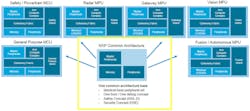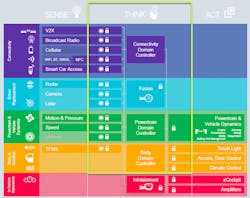NXP’s S32x Family Targets Safe, Secure Automotive Applications
The number of processors and sensors in a car is rapidly increasing bringing more advanced driver assistance system (ADAS) support, but at the cost of added complexity and management. While standard communication interfaces and protocols help, a diverse collection of platforms can make integration and support a major problem. One potential solution is to have a unified compute platform, which is why NXP Semiconductor is pushing its S32x family (Fig. 1).
The S32x family is based on ARM’s Cortex-A cores as well as the Cortex-M and Cortex-R cores. These 32- and 64-bit system-on-chip (SoC) solutions often incorporate a mix of cores, and they can come with large amounts of memory ranging from 512 Kbytes to 128 Mbytes. The family will be designed to deliver ASIL D support. NXP is the first to deliver ASIL D support for Cortex-A class processors. This support is typically found in Cortex-M and Cortex-R class processors.
The chips will find a home in a wide range of automotive services, including gateways providing secure over-the-air (OTA) updates to all systems in the car (Fig. 2). The OTA support is twofold. First, the common, underlying architecture make implementation of secure boot and software updates significantly easier and more consistent between devices in the car’s network. Second, a common update mechanism can be more easily coupled with OTA support, especially as more incremental update procedures are utilized. The days of a single massive update are gone for a variety of reasons, including improved security requirements, a larger code base, and wireless bandwidth limitations. NXP is providing not only hardware, but also the software to support features like OTA.
The breadth of different compute platforms is required to address the many sensor, command, and management services found in highly automated cars (Fig. 3). NXP may not address all the areas using the S32x, but it has marked out a lot of territory. It is also incorporating a variety of hardware accelerators, including neural network acceleration for artificial intelligence and machine learning support that is becoming a requirement.
NXP’s S32x family of automotive-grade silicon is designed to provide a common development platform that can deliver ASIL D fault tolerance, as well as end-to-end security that includes OTA. This should allow for improved software reuse. It is also designed to deliver higher performance.
About the Author
William G. Wong
Senior Content Director - Electronic Design and Microwaves & RF
I am Editor of Electronic Design focusing on embedded, software, and systems. As Senior Content Director, I also manage Microwaves & RF and I work with a great team of editors to provide engineers, programmers, developers and technical managers with interesting and useful articles and videos on a regular basis. Check out our free newsletters to see the latest content.
You can send press releases for new products for possible coverage on the website. I am also interested in receiving contributed articles for publishing on our website. Use our template and send to me along with a signed release form.
Check out my blog, AltEmbedded on Electronic Design, as well as his latest articles on this site that are listed below.
You can visit my social media via these links:
- AltEmbedded on Electronic Design
- Bill Wong on Facebook
- @AltEmbedded on Twitter
- Bill Wong on LinkedIn
I earned a Bachelor of Electrical Engineering at the Georgia Institute of Technology and a Masters in Computer Science from Rutgers University. I still do a bit of programming using everything from C and C++ to Rust and Ada/SPARK. I do a bit of PHP programming for Drupal websites. I have posted a few Drupal modules.
I still get a hand on software and electronic hardware. Some of this can be found on our Kit Close-Up video series. You can also see me on many of our TechXchange Talk videos. I am interested in a range of projects from robotics to artificial intelligence.





